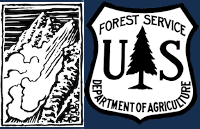Pit from 12/22/21 at 9,850' on the NE face/shoulder of Mt. Blackmore. Snow depth was 111cm, first ECT was ECTN10 below the wind slab then ECTN22 on facets at 70cm. A second test was ECTN17 on that facet layer, then ECTP20 on depth hoar at 35cm. A third ECT was ECTP17 on the facets at 70cm, then a fourth ECT was another ECTP17....
Northern Gallatin
North face of Mt. Blackmore on 12/22/21. South-southwest winds were moderate-strong and scouring more than loading it seemed like, but isolated slabs and whales of snow could be found. We did not get any drifts to crack or collapse. Fresh wind slabs were 2-4" thick, 1f-P hard, and not very continuous. Photo: GNFAC
Mt. Blackmore
I skied Mt. Blackmore this morning. The trail was in much better condition than last week. Good, not great, ski-in/ski-out coverage.
South-southwest winds were moderate-strong and scouring more than loading it seemed like, but isolated slabs and whales of snow could be found. I did not get any drifts to crack or collapse. Fresh wind slabs were 2-4" thick, 1f-P hard, and not very continuous...
I dug a pit high on the NE face/shoulder. As I moved from the ridge to a loaded slope of the face snow depth went from 12" to 36" over about 6 feet. I dug where it was 111cm and my first ECT was ECTN10 below the wind slab then ECTN22 on facets at 70cm. A second test gave ECTN17 on that facet layer, then ECTP20 on depth hoar at 35cm, so I did a third ECT which gave ECTP17 on the facets at 70cm, then a fourth ECT repeated that ECTP17... pit attached. I was moving into shallower snow as I got more unstable results, down to about 90cm HS. Anyway, I didn't think I would trigger an avalanche on that layer, but it did give me pause to be any further out or higher on that face where it was steep. I didn't intend to go higher or further out anyway, mainly due to not wanting to deal with the winds any higher up on the ridge/summit. Even though I feel danger for that PWL is low, the ECTPs were enough to ensure I stayed conservative.
For the long term I think the snowpack is not great, especially the higher you go. We will need to stay conservative with these facets mid-pack (30-70cm) (throughout the area). Since they are not hair-trigger or showing obvious signs of instability with these small recent storms I fear we (or someone) will get surprised with a cumulative loading or big wind event, or who knows... As usual, it comes down to: the snowpack has layers, it could avalanche [at some point, somewhere], be careful out there.
*I will add my pit and photo(s) to the website, I just wanted to test the obs submission form.
History Rock
Found some fassets about 1.5' below the surface after a quick hand pit. Total snow depth was about .5-1' less than my pole.
Lick Creak
My partner and I dug a pit at the bottom of the lick creak meadow today in a wind protected area about 50-60cm deep to dirt. We scored a ECTN 20 and were unable to sheer the column off across the entire 90cm block.
The snow above our pit was significantly shallower and very wind affected with a punchy wind crust in the ski down
Cornices that formed mid-slope, indicating recent heavy wind-loading in the Bridger Range. Strong southwest wind between 12/18 and 12/19/21 drifted recent snow into hard, pillowy drifts. We avoided these drifts on steep slopes to give them a day or two to stabilize. Photo: GNFAC
These pillowy, hard drifts formed from strong southwest wind overnight between 12/18 and 12/19/21 in the Bridger Range. We saw minimal signs of instability, lke whumphing or cracking in these drifts, but avoided these features on steep slopes until they have more time to gain stability. Photo: GNFAC
History Rock top of Upper Meadow
Dug two pits at northern end of the upper meadow just above a rollover. Slope was ~24 degrees, with a little over 30 degrees below the rollowver. Both pits had about 20 inches total, top 10" of new snow on top of a hard crust, faceted snow to the ground. Pit 1 ECTP 10, failing on the crust layer about 10" down. Pit 2 ECTP 0, failing while isolating the column on the crust. Both clean failures on the crust. Lower 10 inches was faceted, but had some cohesion. Several tracks on either side our pits. No sign of other pits. We skied the low angle terrain on the south end of the upper meadow.
